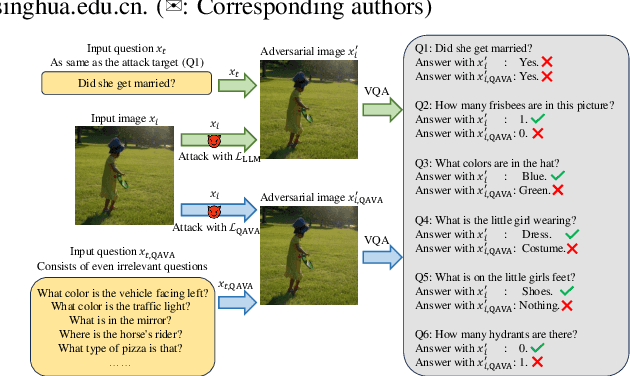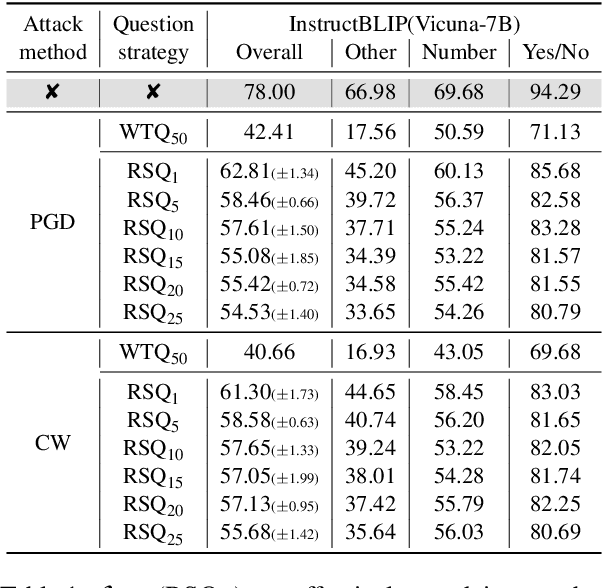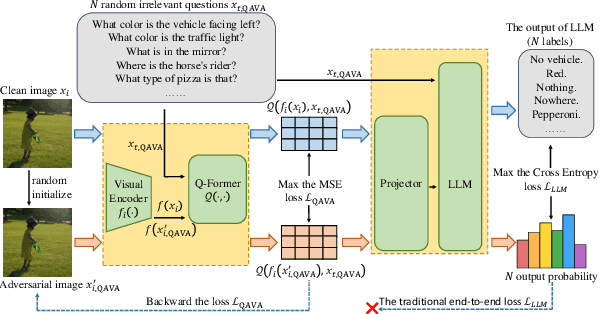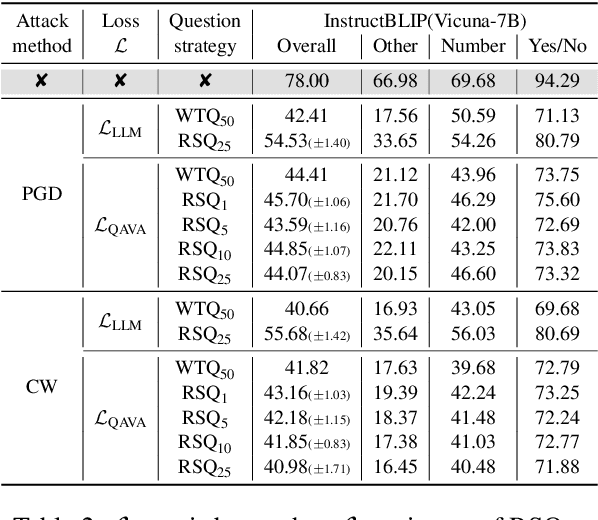Zhanhui Kang
Hybrid-Tower: Fine-grained Pseudo-query Interaction and Generation for Text-to-Video Retrieval
Sep 05, 2025Abstract:The Text-to-Video Retrieval (T2VR) task aims to retrieve unlabeled videos by textual queries with the same semantic meanings. Recent CLIP-based approaches have explored two frameworks: Two-Tower versus Single-Tower framework, yet the former suffers from low effectiveness, while the latter suffers from low efficiency. In this study, we explore a new Hybrid-Tower framework that can hybridize the advantages of the Two-Tower and Single-Tower framework, achieving high effectiveness and efficiency simultaneously. We propose a novel hybrid method, Fine-grained Pseudo-query Interaction and Generation for T2VR, ie, PIG, which includes a new pseudo-query generator designed to generate a pseudo-query for each video. This enables the video feature and the textual features of pseudo-query to interact in a fine-grained manner, similar to the Single-Tower approaches to hold high effectiveness, even before the real textual query is received. Simultaneously, our method introduces no additional storage or computational overhead compared to the Two-Tower framework during the inference stage, thus maintaining high efficiency. Extensive experiments on five commonly used text-video retrieval benchmarks demonstrate that our method achieves a significant improvement over the baseline, with an increase of $1.6\% \sim 3.9\%$ in R@1. Furthermore, our method matches the efficiency of Two-Tower models while achieving near state-of-the-art performance, highlighting the advantages of the Hybrid-Tower framework.
Adaptive Termination for Multi-round Parallel Reasoning: An Universal Semantic Entropy-Guided Framework
Jul 09, 2025Abstract:Recent advances in large language models (LLMs) have accelerated progress toward artificial general intelligence, with inference-time scaling emerging as a key technique. Contemporary approaches leverage either sequential reasoning (iteratively extending chains of thought) or parallel reasoning (generating multiple solutions simultaneously) to scale inference. However, both paradigms face fundamental limitations: sequential scaling typically relies on arbitrary token budgets for termination, leading to inefficiency or premature cutoff; while parallel scaling often lacks coordination among parallel branches and requires intrusive fine-tuning to perform effectively. In light of these challenges, we aim to design a flexible test-time collaborative inference framework that exploits the complementary strengths of both sequential and parallel reasoning paradigms. Towards this goal, the core challenge lies in developing an efficient and accurate intrinsic quality metric to assess model responses during collaborative inference, enabling dynamic control and early termination of the reasoning trace. To address this challenge, we introduce semantic entropy (SE), which quantifies the semantic diversity of parallel model responses and serves as a robust indicator of reasoning quality due to its strong negative correlation with accuracy...
The Climb Carves Wisdom Deeper Than the Summit: On the Noisy Rewards in Learning to Reason
May 28, 2025Abstract:Recent studies on post-training large language models (LLMs) for reasoning through reinforcement learning (RL) typically focus on tasks that can be accurately verified and rewarded, such as solving math problems. In contrast, our research investigates the impact of reward noise, a more practical consideration for real-world scenarios involving the post-training of LLMs using reward models. We found that LLMs demonstrate strong robustness to substantial reward noise. For example, manually flipping 40% of the reward function's outputs in math tasks still allows a Qwen-2.5-7B model to achieve rapid convergence, improving its performance on math tasks from 5% to 72%, compared to the 75% accuracy achieved by a model trained with noiseless rewards. Surprisingly, by only rewarding the appearance of key reasoning phrases (namely reasoning pattern reward, RPR), such as ``first, I need to''-without verifying the correctness of answers, the model achieved peak downstream performance (over 70% accuracy for Qwen-2.5-7B) comparable to models trained with strict correctness verification and accurate rewards. Recognizing the importance of the reasoning process over the final results, we combined RPR with noisy reward models. RPR helped calibrate the noisy reward models, mitigating potential false negatives and enhancing the LLM's performance on open-ended tasks. These findings suggest the importance of improving models' foundational abilities during the pre-training phase while providing insights for advancing post-training techniques. Our code and scripts are available at https://github.com/trestad/Noisy-Rewards-in-Learning-to-Reason.
Hunyuan-TurboS: Advancing Large Language Models through Mamba-Transformer Synergy and Adaptive Chain-of-Thought
May 21, 2025Abstract:As Large Language Models (LLMs) rapidly advance, we introduce Hunyuan-TurboS, a novel large hybrid Transformer-Mamba Mixture of Experts (MoE) model. It synergistically combines Mamba's long-sequence processing efficiency with Transformer's superior contextual understanding. Hunyuan-TurboS features an adaptive long-short chain-of-thought (CoT) mechanism, dynamically switching between rapid responses for simple queries and deep "thinking" modes for complex problems, optimizing computational resources. Architecturally, this 56B activated (560B total) parameter model employs 128 layers (Mamba2, Attention, FFN) with an innovative AMF/MF block pattern. Faster Mamba2 ensures linear complexity, Grouped-Query Attention minimizes KV cache, and FFNs use an MoE structure. Pre-trained on 16T high-quality tokens, it supports a 256K context length and is the first industry-deployed large-scale Mamba model. Our comprehensive post-training strategy enhances capabilities via Supervised Fine-Tuning (3M instructions), a novel Adaptive Long-short CoT Fusion method, Multi-round Deliberation Learning for iterative improvement, and a two-stage Large-scale Reinforcement Learning process targeting STEM and general instruction-following. Evaluations show strong performance: overall top 7 rank on LMSYS Chatbot Arena with a score of 1356, outperforming leading models like Gemini-2.0-Flash-001 (1352) and o4-mini-2025-04-16 (1345). TurboS also achieves an average of 77.9% across 23 automated benchmarks. Hunyuan-TurboS balances high performance and efficiency, offering substantial capabilities at lower inference costs than many reasoning models, establishing a new paradigm for efficient large-scale pre-trained models.
Low-hallucination Synthetic Captions for Large-Scale Vision-Language Model Pre-training
Apr 17, 2025Abstract:In recent years, the field of vision-language model pre-training has experienced rapid advancements, driven primarily by the continuous enhancement of textual capabilities in large language models. However, existing training paradigms for multimodal large language models heavily rely on high-quality image-text pairs. As models and data scales grow exponentially, the availability of such meticulously curated data has become increasingly scarce and saturated, thereby severely limiting further advancements in this domain. This study investigates scalable caption generation techniques for vision-language model pre-training and demonstrates that large-scale low-hallucination synthetic captions can serve dual purposes: 1) acting as a viable alternative to real-world data for pre-training paradigms and 2) achieving superior performance enhancement when integrated into vision-language models through empirical validation. This paper presents three key contributions: 1) a novel pipeline for generating high-quality, low-hallucination, and knowledge-rich synthetic captions. Our continuous DPO methodology yields remarkable results in reducing hallucinations. Specifically, the non-hallucination caption rate on a held-out test set increases from 48.2% to 77.9% for a 7B-size model. 2) Comprehensive empirical validation reveals that our synthetic captions confer superior pre-training advantages over their counterparts. Across 35 vision language tasks, the model trained with our data achieves a significant performance gain of at least 6.2% compared to alt-text pairs and other previous work. Meanwhile, it also offers considerable support in the text-to-image domain. With our dataset, the FID score is reduced by 17.1 on a real-world validation benchmark and 13.3 on the MSCOCO validation benchmark. 3) We will release Hunyuan-Recap100M, a low-hallucination and knowledge-intensive synthetic caption dataset.
QAVA: Query-Agnostic Visual Attack to Large Vision-Language Models
Apr 15, 2025



Abstract:In typical multimodal tasks, such as Visual Question Answering (VQA), adversarial attacks targeting a specific image and question can lead large vision-language models (LVLMs) to provide incorrect answers. However, it is common for a single image to be associated with multiple questions, and LVLMs may still answer other questions correctly even for an adversarial image attacked by a specific question. To address this, we introduce the query-agnostic visual attack (QAVA), which aims to create robust adversarial examples that generate incorrect responses to unspecified and unknown questions. Compared to traditional adversarial attacks focused on specific images and questions, QAVA significantly enhances the effectiveness and efficiency of attacks on images when the question is unknown, achieving performance comparable to attacks on known target questions. Our research broadens the scope of visual adversarial attacks on LVLMs in practical settings, uncovering previously overlooked vulnerabilities, particularly in the context of visual adversarial threats. The code is available at https://github.com/btzyd/qava.
Large Language Model Empowered Recommendation Meets All-domain Continual Pre-Training
Apr 11, 2025Abstract:Recent research efforts have investigated how to integrate Large Language Models (LLMs) into recommendation, capitalizing on their semantic comprehension and open-world knowledge for user behavior understanding. These approaches predominantly employ supervised fine-tuning on single-domain user interactions to adapt LLMs for specific recommendation tasks. However, they typically encounter dual challenges: the mismatch between general language representations and domain-specific preference patterns, as well as the limited adaptability to multi-domain recommendation scenarios. To bridge these gaps, we introduce CPRec -- an All-domain Continual Pre-Training framework for Recommendation -- designed to holistically align LLMs with universal user behaviors through the continual pre-training paradigm. Specifically, we first design a unified prompt template and organize users' multi-domain behaviors into domain-specific behavioral sequences and all-domain mixed behavioral sequences that emulate real-world user decision logic. To optimize behavioral knowledge infusion, we devise a Warmup-Stable-Annealing learning rate schedule tailored for the continual pre-training paradigm in recommendation to progressively enhance the LLM's capability in knowledge adaptation from open-world knowledge to universal recommendation tasks. To evaluate the effectiveness of our CPRec, we implement it on a large-scale dataset covering seven domains and conduct extensive experiments on five real-world datasets from two distinct platforms. Experimental results confirm that our continual pre-training paradigm significantly mitigates the semantic-behavioral discrepancy and achieves state-of-the-art performance in all recommendation scenarios. The source code will be released upon acceptance.
TransMamba: Flexibly Switching between Transformer and Mamba
Mar 31, 2025Abstract:Transformers are the cornerstone of modern large language models, but their quadratic computational complexity limits efficiency in long-sequence processing. Recent advancements in Mamba, a state space model (SSM) with linear complexity, offer promising efficiency gains but suffer from unstable contextual learning and multitask generalization. This paper proposes TransMamba, a novel framework that unifies Transformer and Mamba through shared parameter matrices (e.g., QKV and CBx), and thus could dynamically switch between attention and SSM mechanisms at different token lengths and layers. We design the Memory converter to bridge Transformer and Mamba by converting attention outputs into SSM-compatible states, ensuring seamless information flow at TransPoints where the transformation happens. The TransPoint scheduling is also thoroughly explored for further improvements. We conducted extensive experiments demonstrating that TransMamba achieves superior training efficiency and performance compared to baselines, and validated the deeper consistency between Transformer and Mamba paradigms, offering a scalable solution for next-generation sequence modeling.
PatchRec: Multi-Grained Patching for Efficient LLM-based Sequential Recommendation
Jan 25, 2025Abstract:Large Language Models for sequential recommendation (LLM4SR), which transform user-item interactions into language modeling, have shown promising results. However, due to the limitations of context window size and the computational costs associated with Large Language Models (LLMs), current approaches primarily truncate user history by only considering the textual information of items from the most recent interactions in the input prompt. This truncation fails to fully capture the long-term behavioral patterns of users. To address this, we propose a multi-grained patching framework -- PatchRec. It compresses the textual tokens of an item title into a compact item patch, and further compresses multiple item patches into a denser session patch, with earlier interactions being compressed to a greater degree. The framework consists of two stages: (1) Patch Pre-training, which familiarizes LLMs with item-level compression patterns, and (2) Patch Fine-tuning, which teaches LLMs to model sequences at multiple granularities. Through this simple yet effective approach, empirical results demonstrate that PatchRec outperforms existing methods, achieving significant performance gains with fewer tokens fed to the LLM. Specifically, PatchRec shows up to a 32% improvement in HR@20 on the Goodreads dataset over uncompressed baseline, while using only 7% of the tokens. This multi-grained sequence modeling paradigm, with an adjustable compression ratio, enables LLMs to be efficiently deployed in real-world recommendation systems that handle extremely long user behavior sequences.
Scaling Laws for Floating Point Quantization Training
Jan 05, 2025



Abstract:Low-precision training is considered an effective strategy for reducing both training and downstream inference costs. Previous scaling laws for precision mainly focus on integer quantization, which pay less attention to the constituents in floating-point quantization and thus cannot well fit the LLM losses in this scenario. In contrast, while floating-point quantization training is more commonly implemented in production, the research on it has been relatively superficial. In this paper, we thoroughly explore the effects of floating-point quantization targets, exponent bits, mantissa bits, and the calculation granularity of the scaling factor in floating-point quantization training performance of LLM models. While presenting an accurate floating-point quantization unified scaling law, we also provide valuable suggestions for the community: (1) Exponent bits contribute slightly more to the model performance than mantissa bits. We provide the optimal exponent-mantissa bit ratio for different bit numbers, which is available for future reference by hardware manufacturers; (2) We discover the formation of the critical data size in low-precision LLM training. Too much training data exceeding the critical data size will inversely bring in degradation of LLM performance; (3) The optimal floating-point quantization precision is directly proportional to the computational power, but within a wide computational power range, we estimate that the best cost-performance precision lies between 4-8 bits.
 Add to Chrome
Add to Chrome Add to Firefox
Add to Firefox Add to Edge
Add to Edge